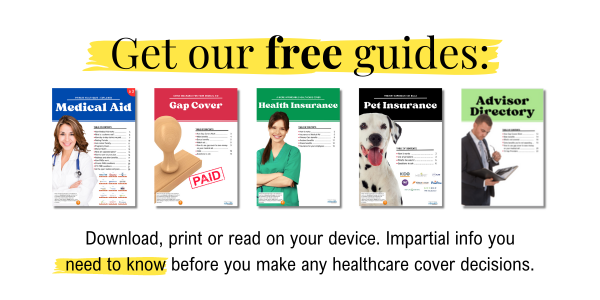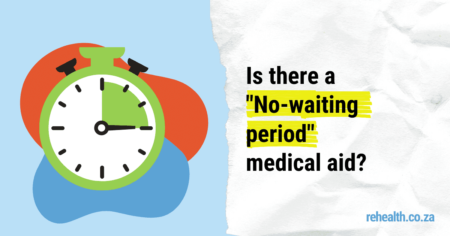What is a medical aid waiting period?
Waiting periods are periods of time during which a medical aid member will receive limited or no benefit for certain claims. They are imposed on new scheme members only. Members who change plans within the same scheme will not have new waiting periods.
There are two factors that determine how long the waiting period will be:
- Your past 12-month medical history
- Your past 24-month medical aid membership history
The application of waiting periods by a scheme is known as “underwriting”.
What you need to know about PMBs to understand waiting periods
We have a good write up on PMBs here.
In brief: a “PMB condition” is any of 270+ conditions prescribed by the Medical Schemes Act. Your medical aid needs to provide you with at least a minimum set of benefits for these conditions. You can find the conditions and their minimum treatments here. All life threatening conditions are PMBs.
Remember:
“PMB-only” benefits are weaker than full benefits, but much better than “no benefits”.
What types of waiting periods are there?
There are four types of waiting periods. More than one type can apply to you. We first discuss the different types, and then we’ll talk about which waiting period applies in which situation.
A. 3 month general waiting period, including PMBs
This waiting period affects healthcare cover for the first 3 months of membership for all healthcare services. It means you are paying for 3 months, but getting no benefits for those 3 months. You will also not have access to your savings account, if your plan includes one.
Under this waiting period, if you have a car accident, you are not covered by your medical aid for treatment.
B. 3 month general waiting period, excluding PMBs
This waiting period affects healthcare cover for the first 3 months of membership for most healthcare services, but not ones that fall under the PMB definition.
Under this waiting period, if you have a car accident, you are covered by your medical aid for treatment of all life threatening conditions and other PMB conditions that arise as a result of the accident. But you will not have access to elective, non-PMB cover, even if your doctor thinks it is necessary.
Note that during the waiting period, the schemes are obliged to only offer coverage for PMBs according to “the PMB level of care” ie. through designated providers, which sometimes may include state hospitals only (depending on the plan).
C. 12 month specific condition waiting period, including PMBs
Schemes can sometimes restrict treatment to new members for certain conditions for which “medical advice, diagnosis, care or treatment was recommended or received within the 12-month period ending on the date on which an application was made“. Even if some schemes ask for a medical history that extends beyond the past 12 months, they are not allowed to impose restrictions based on any medical history older than 12 months.
This waiting period also excludes treatment of PMB conditions.
D. 12 month specific condition waiting period, excluding PMBs
As above, except that this waiting period allows treatment of PMB conditions, at the “PMB level of care”. In other words, past conditions that fall under PMB conditions, cannot be excluded by the waiting period.
Top Tip: Consider timing your scheme change correctly, to possibly avoid this 12 month waiting period.
See our examples below.
What waiting period applies to you?
Your specific circumstance will determine which of the four types of waiting periods will apply to you.
1. If you want to change plans within the same scheme:
No waiting period can be applied, although any current waiting periods will continue until they expire.
2. If you are changing schemes involuntarily due to change in employment:
No waiting period can be applied, although any current waiting periods will continue until they expire.
3. If you have not been a member of another scheme for more than 90 days:
Waiting Periods A and C can be applied (see above).
In other words, you will have a 3 month general waiting period with no benefits AND a condition-specific waiting period for 12 months, (if you have pre-existing condition for which you have received treatment or advice in the last year).
4. If you have been a member of a scheme(s) for less than 24 continuous months.
Only Waiting Periods D can be applied.
In other words, you will NOT have a general 3 month waiting period, but you WILL have a 12 month condition-specific waiting period during which you will receive only PMB level of care for that condition.
5. If you have been a member of a scheme for the past 24 continuous months or longer
Only Waiting Period B can be applied (ie there is no specific condition waiting period).
In other words, you will have a general 3 month waiting period during which you will only receive PMB level of care for any condition. You will NOT have a condition-specific 12 month waiting period.
Good news! Under this scenario, if you and your dependants have not been hospitalised in the past 12 months and are not on any medication/treatment, then Discovery will waive the 3 month waiting period for you.
It’s all at the discretion of the scheme
Schemes cannot impose more exclusions than allowed by law, but they can impose less. Speak to your potential new scheme to get clarification regarding waiting periods in your specific case. Some schemes are getting very inventive with how they work with new members.
Some examples:
Please note that these are for illustrative purpose only, and are written in very general terms. Any scheme can impose less onerous waiting periods at its discretion. Always speak to your broker and scheme before switching plans, or signing up for a new medical aid.
Example 1:
Ann is a cancer patient, and has been a member of Discovery Core plan for 6 years.
If Ann changes to Discovery Comprehensive, she will not have any waiting periods. She can only upgrade her plan on January 1, though.
If Ann wants to change to another scheme (Bonitas, Compcare etc), she will have a 3 month general waiting period. Her cancer will be covered at PMB level of care. This means she might receive lower-level treatment for those 3 months than she is used to on her current plan.
Example 2
Freddy has been diagnosed with asthma. He has never had medical aid but wants to join one, because he knows that asthma is a PMB and a medical aid will pay for his treatment.
Freddy can join any open medical aid, but his asthma will fall under the 12-month waiting period, even though it’s a PMB. He will also have a 3 month general waiting period during which he will not receive any benefit from his medical aid. If Freddy is over 35yrs, he will also pay a late joiner penalty.
Example 3
Sophie has been diagnosed with asthma. She has been a member of a medical aid for 23 months.
If Sophie changes plans within her scheme, she will not receive a waiting period and her asthma will be covered.
Because Sophie has been a member of a medical aid for less than 24 months, if she changes schemes, she will not have a general waiting period, but will have a 12 month waiting period for her asthma during which time it will only be covered at PMB level of care.
If Sophie waits 2 months to change schemes, she will not have a waiting period for her asthma, but will have a 3 month general waiting period. During this time, she will be covered for all PMB conditions, including her asthma.
Further reading
You might also be interested in Late Joiner Penalties.









